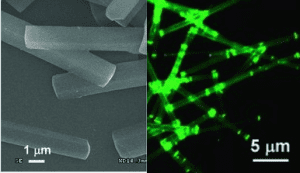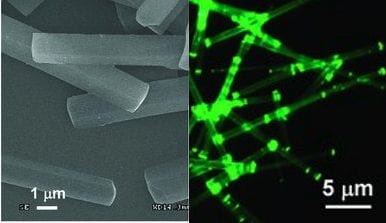Low-threshold nanolasers based on slab-nanocrystals of H-aggregated organic semiconductors are reported by Hongbing Fu and co-workers at the Chinese Academy of Sciences.
Nanolasers have potential for applications ranging from on-chip optical communications to high-throughput sensing. However, while the nanowires are on the nanometer scale in two dimensions, the lasing cavity needs to be approximately 10 micrometers to build up enough gain for lasing.
 Fu and colleagues investigated rectangular slab nanocrystals of 1,4-dimethoxy–2,5-di[4’-(methylthio)styryl]benzene, in which H-aggregation is promoted by tight co-facial molecular packing. The slab nano crystals exhibit excellent lasing properties, with optimized energy levels that not only reduce the self-absorption effect but also minimize the radiative loss of the excition reservoir.
Fu and colleagues investigated rectangular slab nanocrystals of 1,4-dimethoxy–2,5-di[4’-(methylthio)styryl]benzene, in which H-aggregation is promoted by tight co-facial molecular packing. The slab nano crystals exhibit excellent lasing properties, with optimized energy levels that not only reduce the self-absorption effect but also minimize the radiative loss of the excition reservoir.
The researchers achieved a lasing threshold as low as 100 nJ cm–2. And, the laser light generated in the local radial cavity (500 – 2000 nm) of SNC can propagate along its length up to hundreds of micrometers, making them attractive building blocks ready for miniaturized photonic circuits.
The research was reported in Advanced Optical Materials, a new section in Advanced Materials dedicated to breakthrough discoveries and fundamental research in photonics, plasmonics, metamaterials, and more, covering all aspects of light-matter interactions. To get Advanced Optical Materials email alerts, click here.
The paper, “Low-Threshold Nanolasers Based on Slab-Nanocrystals of H-Aggregated Organic Semiconductors”, is free to download for a limited time.

















